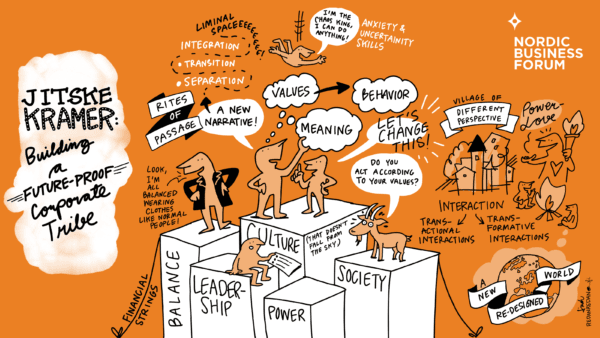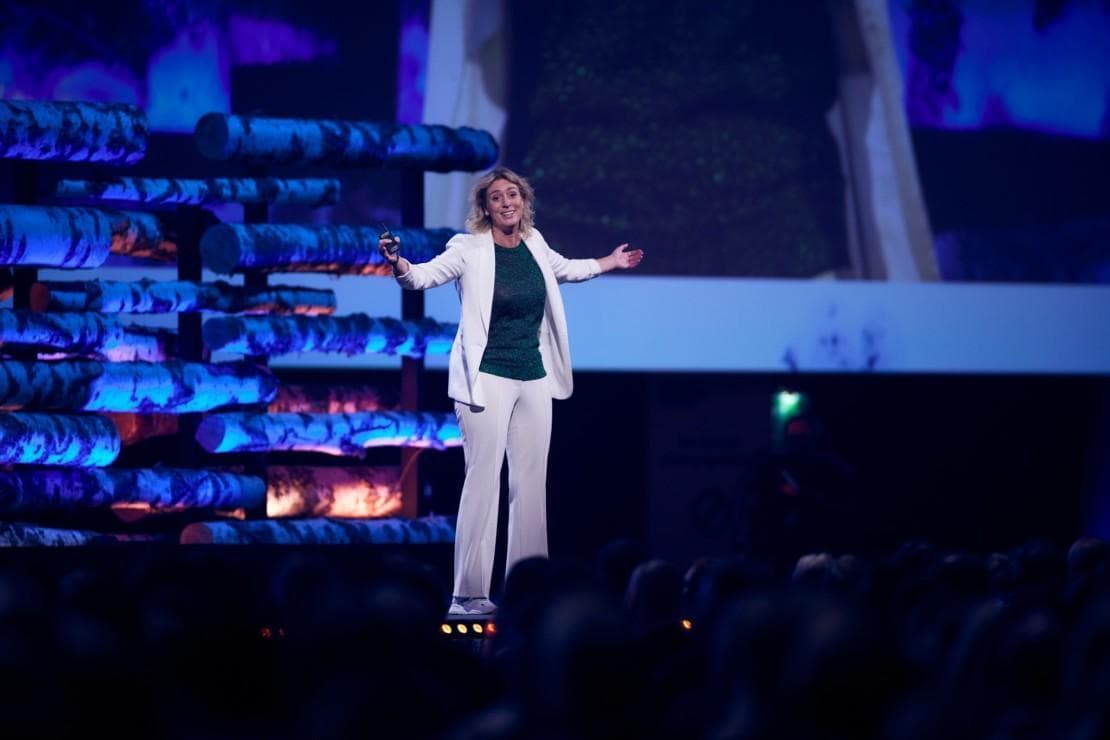23Sep2022
Jitske Kramer is a corporate anthropologist. Contrary to what many people think, she argued that anthropology holds vital information that can help leaders in all types of organizations to create the future they want. Why? Because “we shape the future through every action we take, and the dreams we chase, and the stories we tell”. And behind everything we think, say, and do, lies culture.
The Culture-shaping Process
“Cultures don’t fall from the sky,” exclaimed Kramer.
“Nothing has meaning in itself, culture is a sense-giving system, and we create it together.” This process runs as follows: people define values (or what is important to them), values influence how people act, and behaviors, in turn, mold the physical world. For example, offices in companies that value directive leadership—and consequently, whose leaders wield centralized and undivided power––build big corner offices for their top management. These are different from smaller and open spaces in companies that value other kinds of leadership styles.
Kramer pointed out that we create meaning together in interaction and decision-making processes: who joins each interaction, who decides what. And that’s where leaders come in. For example, if there is an important meeting to decide where money will be spent, who can participate in that conversation? There are many kinds of interactions, but two stand out in the decision-making process:
- Transactional interactions, which Kramer also called “bullet point meetings”, where typically people are told what to do.
- Transformative interactions, or “campfire conversations”. These are deeper conversations, in which participants share what’s on their minds, are open to hearing what other people say, and transform their ideas if the conversation leads them to think differently. “True conversations in which we go into our worries and what needs to be done. We open our hearts and souls and minds and speak up.”
Campfire conversations are crucial in culture-shaping processes. It would be very hard to undertake transformations if there were only back-to-back meetings and transactional interactions.
How to Jumpstart a Cultural Change
Cultures are not static, they constantly change through every micro-decision. But this is a slow process, and sometimes you need to jump-start it and make a significant transformation. “How do we do that? We change our narratives”.
Kramer explained that people change in three steps:
- Separation phase: We understand that the values we held for a long time are outdated.
- Transition phase: Things are unclear and we attempt to find new answers.
- Integration: We integrate what we’ve learned during the transition into our life.
Here again, Kramer used an anthropological concept and defined the transition phase as a “liminal space”, a period that is characterized by “what was no longer is, what will be is not here yet, what we have is chaos and uncertainty, and the future is the domain of the unknown”. This lack of clarity makes most people anxious and scared and pushes them to end it quickly. However, a deep transformation requires a prolonged liminal space because it takes time to create a new narrative. “We have to go through bits and pieces before we find a new answer.”
The transition phase calls for leaders who can take care of the day-to-day work (the bullet point interactions) but can also handle chaos and uncertainty. Examples of these kinds of leaders are shamans, magicians, or even artists; people who can picture what is not there yet and can facilitate a “magical time” during transformations.
From Conversations to Practice
“Magical times are announced by rituals”, said Kramer.
The power of a ritual is to create and hold a space to rethink the normal and to take a different approach. In our private life, we use rituals to make it clear that we are moving from one space to another. Think of a graduation ceremony that marks the shift from being a student to a professional, or a wedding day to go from being single to being a married person. The same holds true for organizations. “You can’t say: let’s have different corporate values, put communication on it, change the website, and roll it out over to people. It doesn’t work like that”. Organizations also need rituals, in this case, authentic conversations, because cultural transformation is a new collective pattern of thoughts, beliefs, and behaviors.
As the presentation drew to a close, Kramer posed a final question: How can you put new values into practice? The answer rests on power and love. On one hand, the force of power is needed to define goals, set boundaries, and push anything that could hinder achieving results. “We need dopamine in the system which makes us feel good. If we don’t have power, if we are not rebellious, nothing will change.”
The second force is love, a deep connection or engagement. “We need oxytocin in the system, feeling we are together, that we are proud of each other.”
Kramer concluded her talk with a phrase that summarized her presentation: “People shape culture, and culture shapes people” and advised leaders to have the courage to change their behavior and redesign the world into the future they want.

Sketchnote of the keynote by Linda Saukko-Rauta


